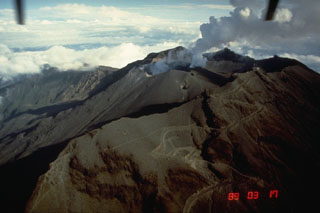Report on Galeras (Colombia) — 16 January-22 January 2008
Smithsonian Institution / US Geological Survey
Weekly Volcanic Activity Report, 16 January-22 January 2008
Managing Editor: Sally Sennert.
Please cite this report as:
Global Volcanism Program, 2008. Report on Galeras (Colombia) (Sennert, S, ed.). Weekly Volcanic Activity Report, 16 January-22 January 2008. Smithsonian Institution and US Geological Survey.
Galeras
Colombia
1.22°N, 77.37°W; summit elev. 4276 m
All times are local (unless otherwise noted)
INGEOMINAS issued a report at 1000 on 17 January, noting that the seismic pattern from Galeras observed during the previous 24 hours was similar to patterns noted before past eruptions. Later that day, at 2006, an explosive eruption was registered by the seismic network and prompted INGEOMINAS to raise the Alert Level from 3 ("changes in the behavior of volcanic activity have been noted") to 1 ("imminent eruption or in course"), on a scale of 4-1.
Based on observations of satellite imagery and information from INGEOMINAS, the Washington VAAC reported that an ash plume rose to an altitude of 11 km (36,000 ft) a.s.l. at 2216 and drifted W on 17 January.
On 19 January, INGEOMINAS lowered the Alert Level to 2 ("likely eruption in days or weeks") because seismic events decreased in occurrence and energy. On 21 January, INGEOMINAS further lowered the Alert Level to 3 and reported that the initial ash plume from the eruption drifted SW, then W. Fine Ashfall was collected in Túquerres (about 32 km to the SW) and very fine ash was observed in neighborhoods of Ricaurte (about 71 km to the W). About 2 km away, military personnel reported that blocks 1.5 m in diameter were noted on a highway.
According to a news article, small settlements to the N were ordered to evacuate; about 100 people moved to shelters.
Geological Summary. Galeras, a stratovolcano with a large breached caldera located immediately west of the city of Pasto, is one of Colombia's most frequently active volcanoes. The dominantly andesitic complex has been active for more than 1 million years, and two major caldera collapse eruptions took place during the late Pleistocene. Long-term extensive hydrothermal alteration has contributed to large-scale edifice collapse on at least three occasions, producing debris avalanches that swept to the west and left a large open caldera inside which the modern cone has been constructed. Major explosive eruptions since the mid-Holocene have produced widespread tephra deposits and pyroclastic flows that swept all but the southern flanks. A central cone slightly lower than the caldera rim has been the site of numerous small-to-moderate eruptions since the time of the Spanish conquistadors.
Sources: Associated Press, Servicio Geológico Colombiano (SGC), Washington Volcanic Ash Advisory Center (VAAC)

